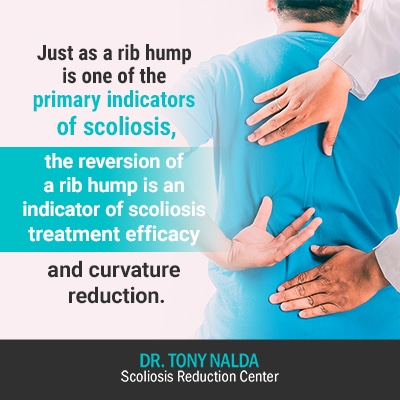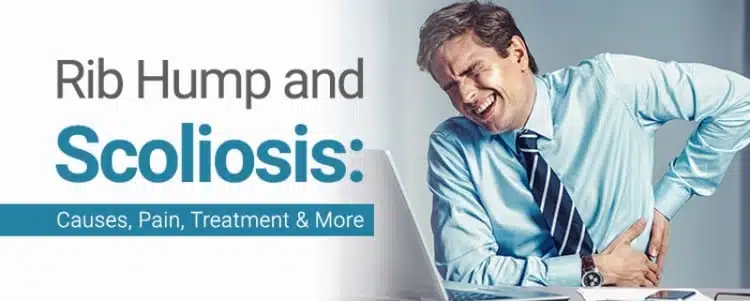In the condition’s most common form, adolescent idiopathic scoliosis, the condition isn’t painful, and mild forms don’t commonly produce noticeable postural changes, unless you are an expert who knows exactly what to look for. While scoliosis can develop anywhere along the spine, it’s most common along the thoracic spine, and as the spine is attached to the rib cage, it’s not uncommon for a rib hump to develop as scoliosis progresses.
As a progressive condition, there are different stages to scoliosis severity, ranging from mild to severe. Particularly common with curvatures along the thoracic spine, a rib hump can develop due to the asymmetry and rotational component caused by the abnormal sideways spinal curvature.
Before we start talking about the specifics of how and why a rib hump develops as a scoliosis symptom, we’re going to first spend some time defining scoliosis and some of its main characteristics.
What is Scoliosis?
Scoliosis is a spinal condition with a surprisingly high prevalence. The National Scoliosis Foundation puts current estimates at close to seven million people living with scoliosis in the United States alone.
Scoliosis is the leading spinal condition amongst school-aged children, and keep in mind that these estimates are only ‘known’ diagnosed cases.
As mentioned, the condition’s most common form is adolescent idiopathic scoliosis (AIS), meaning the condition is diagnosed between the ages of 10 and 18 and the condition has no known single cause, hence the ‘idiopathic’ classification.
This form accounts for 80 percent of known cases; the remaining 20 percent consists of different forms with known causes such as congenital, neuromuscular, degenerative, or traumatic.
Essentially, scoliosis is an abnormal sideways curvature to the spine with rotation, meaning it bends and twists, and there is a huge range of severity within the condition as it can be classified as mild, moderate, severe, or very severe.
How is the condition classified on its severity scale? The patient’s Cobb angle, obtained via X-ray, tells us just how far out of alignment a scoliotic spine is; this determines how severe the abnormal curvature is and helps guide the treatment approach moving forward.
Cobb Angle
‘Cobb angle’ is known as the orthopedic gold standard for assessing scoliosis.
In order for a scoliosis diagnosis to be reached, the patient has to have a minimum Cobb angle measurement of 10 degrees, plus rotation.
- Mild scoliosis: Cobb angle measurement of between 10 and 25 degrees
- Moderate scoliosis: Cobb angle measurement of between 25 and 40 degrees
- Severe scoliosis: Cobb angle measurement of 40+ degrees
- Very-severe scoliosis: Cobb angle measurement of 80+ degrees
Even within each of these severity levels, symptoms can vary, and two people with similar-sized curvatures can have vastly different experiences of their condition.
From a patient’s scoliosis X-ray, I can tell how severe their curvature is, as well as where along the spine it’s located.
There are three main sections to the spine: cervical (neck), thoracic (middle and upper), and lumbar (lower). While scoliosis can develop anywhere along the spine, it most commonly appears along the thoracic spine, which also happens to be one of the more likely curvature patterns to progress.
While condition severity helps determine likely symptoms a patient will experience, such as the presence of a rib hump, other factors such as curvature pattern, rotation, and progression also play a role.
Progression
One of the defining features of scoliosis is its progressive nature, meaning it’s going to get worse over time.
This informs the treatment process because while we want to catch any medical condition sooner than later, when it comes to progressive conditions, early detection is even more important.
It’s easier and less complex to work towards reducing a smaller spinal curvature, and it’s also easier to treat an abnormal spinal curvature before the body has had time to adjust.
Here at the Scoliosis Reduction Center®, everything we do is with the end-goal of helping patients avoid the hardships of reaching the higher stages of progression. We don’t want our patients to face the obvious postural changes and potential complications that accompany more severe forms of the condition; we want to catch it early, treat it fast, and control that patient’s progressive line as much as we can.

While early detection doesn’t guarantee a positive treatment outcome every time, it certainly increases the chances of treatment efficacy.
As a person’s condition progresses, this means their abnormal spinal curvature is increasing in size, along with related symptoms such as postural changes. While there are certain patient and condition characteristics such as age, gender, and condition severity that help us gauge a patient’s ‘likeliest’ rate of progression, no one can tell exactly how quickly, or slowly, a curvature is going to progress; we just know that, at some point, it will.
It’s no coincidence that the majority of my patients are in the moderate-scoliosis stage because it’s often once patients progress past the mild stage that symptoms, such as rib humps, become noticeable and bring them in for a diagnosis.
Postural Signs of Scoliosis
As mentioned, in AIS, the condition is not painful, making early detection even more of a challenge, especially when the condition is mild and not producing noticeable postural symptoms. While a scoliosis expert would likely be able to spot the condition’s earliest and most-subtle signs, this would be far harder for an average person, especially if they have no idea what to look for.
While every case is different, generally, the most obvious, telltale signs of scoliosis in adolescents are related to posture, symmetry, the appearance of the shoulder blades, shoulders, hips and back.
Following are common signs of scoliosis related to posture and appearance:
- Ribs that protrude more on one side
- Ribs that protrude when in a forward-bend position
- Unevenness during motion
- Arms held tightly to the sides when walking
- One hip that’s more prominent than the other
- A head that appears uncentered over the body
- One shoulder blade that sits higher than the other
- One leg appears shorter than the other
- Clothing that fits unevenly
- Eye line appears tilted
- Spinal curvature that’s visible to the naked eye
These signs of scoliosis are the most overt, especially once a condition progresses past the mild stage, and they represent symptoms of the underlying structural nature of the condition.
Now that we are discussing the visual changes that scoliosis can cause, as the spine is attached to the rib cage, let’s turn our attention to the rib hump that so often accompanies thoracic scoliosis.
Rib Humps and Scoliosis
As scoliosis is a spinal condition that often includes a rib deformity, there can be a negative association with the term ‘rib hump’. Fortunately, this negative, and incorrect, perception has changed over the years, and when we now use the term ‘rib hump’, we are strictly referring to the rib deformity and rib depression that can develop as a scoliosis symptom, without the negative connotations previously associated with the term.
A rib hump is a primary indicator of scoliosis, as well as the condition’s progression in adolescents. If there is asymmetry in the rib height causing one side of the rib cage to protrude more than the other, this is due to the presence of an abnormal spinal curvature, commonly along the thoracic spine.
While condition severity does play a role in experienced symptoms and symptom severity, as a complex 3-dimensional condition, it’s not solely how large a spinal curvature is that determines the presence and size of a rib hump, but also the degree of rotation.
Rib Hump Causes
The spinal cord runs through the spinal canal, located towards the back of the spine, not the middle as many people assume. Due to the spinal cord’s flexibility, it can travel along the spine’s natural curvatures.
In a healthy spinal cord, with no adverse nerve tension, the spinal cord can stretch and flex to accommodate the body’s movement. In fact, the spinal cord has been known to elongate by 5 to 7 cms when fully flexed.
When nerve tension is present, it effectively results in a shorter spinal cord. When nerve tension and a shorter cord are present, the spinal cord can’t stretch as far and will take the shortest path possible to span the length of the spine as necessary; this means the spinal cord is pulled even tighter.
When a tight cord is being pulled tighter, the spinal cord wants to escape that adverse spinal tension and does so by rotating in order to find that shortest path.
As the spine travels through the spinal canal near the rear of the spine, this rotation helps give the spinal cord a shorter path to traverse; it’s this nerve- and tension-driven rotation that results in the formation of a rib hump, regarded by some as the driving force behind AIS onset.
Fortunately, there are noninvasive screening tests such as the Adam’s forward bend test that can reveal if a patient has any scoliosis-related postural asymmetries and their angle of trunk rotation (ATR).
Adam’s Forward Bend Test
When in a forward-bend position, the spinal cord is pulled tighter, so a crooked spine or any related asymmetries are far more noticeable in this position, hence why the Adam’s forward bend test is such a widespread scoliosis screening method.
While a person with scoliosis can look normal from the rear when they are standing, when bent forward in a 90-degree angle, as in the Adam’s forward bend test, the spinal cord is shortened and tightened due to nerve tension; this is where we encounter the bones of the spine (vertebrae) rotating to provide that shorter path. Due to the rotation, the rib cage distorts, and a rib hump is more evident and identifiable as a scoliosis indicator.

Just as a rib hump is one of the primary indicators of scoliosis, the reduction of a rib hump is an indicator of scoliosis treatment efficacy and curvature reduction.
Scoliosis Rib Hump Treatment
When it comes to scoliosis treatment, here at the Center, we don’t just want to address or treat a symptom of a patient’s condition, we want to treat the underlying cause, which is the condition itself.
So in order to address a scoliosis patient’s rib hump, we do so by, first and foremost, impacting the condition on a structural level, meaning achieving a curvature reduction.
I offer my patients a proactive functional and integrative approach to scoliosis treatment, and that means a fully customized treatment plan that draws from multiple treatment disciplines to achieve the best possible results.
The Center’s treatment disciplines are scoliosis-specific and include chiropractic care, in-office therapy, custom-prescribed home exercises, and specialized corrective bracing.
As the structural nature of the condition is being addressed, related and experienced symptoms are also being addressed, because their underlying cause is the guiding force behind the treatment.
When scoliosis is present, the condition disrupts the spine’s biomechanics and introduces adverse spinal tension. As we work towards reducing an abnormal spinal curvature, the spine’s overall biomechanics are improved and nerve tension is reduced, restoring length and flexibility to the spinal cord.
As the spine’s healthy curvatures are restored, the overall health of the spine is improved upon, and related postural symptoms such as rib humps are also improved upon.
Additional reading: Dowager’s Hump: What Is It, Symptoms, Diagnosis, & Treatment
Are Scoliosis Rib Humps Painful?
Scoliosis in children and adolescents is not generally a painful condition; this is because in people who have not yet reached skeletal maturity, the spine is still growing, meaning it’s not vulnerable to the compressive force of the curvature.
As mentioned, scoliosis is far more common in children and adolescents, but adults can develop it too. For adults, scoliosis can be quite painful; they are no longer growing and experience compression of the spine and its surrounding vessels, nerves and muscles. So a rib hump is more likely to be painful for adults, than it would be for children and adolescents.
Now, in some cases, as scoliosis progresses into the severe and very-severe stage, lung impairment can develop as a potential complication. As the spine is attached to the rib cage, a thoracic curvature can pull on the rib cage and distort its positioning, leaving the lungs with less room to inhale/exhale fully; this biomechanical rib cage dysfunction can lead to rib and chest pain, but is most likely to be problematic for people who place higher-than-average demands on their respiratory systems, such as long-distance runners and professional athletes.
So generally speaking, scoliosis-related rib humps are not particularly painful in children and adolescents; in adults, however, scoliosis-related pain due to the asymmetrical effects of the condition make them more likely to experience pain than adolescents.
As always, the best remedy for scoliosis-related pain is proactive and functional treatment that addresses its underlying cause: scoliosis.
Conclusion
When a person receives a scoliosis diagnosis, it’s hard for them to know what to expect. It’s particularly hard to answer questions like, “How bad can it get?” or “Will it change the way I look?” These are difficult questions to answer because every patient I see has a condition as unique as they are.
While we can do our best to prepare patients for what might be coming and what the realities of living with scoliosis might be like, there is no full-proof way to tell how fast a patient’s condition will progress, or what symptoms they are going to experience.
That being said, generally, the more severe a person’s condition is, the more likely it is to cause noticeable symptoms and pain, especially in adults.
While a rib hump is a common postural change related to thoracic scoliosis and progression in adolescents, it isn’t just related to curvature size, but also the degree of rotation.
When it comes to treating a rib hump proactively, here at the Scoliosis Reduction Center®, we would address it by impacting the condition on a structural level. As we work towards a curvature reduction, we are restoring the spine’s overall health and biomechanics, and treating the rib hump along the way.





